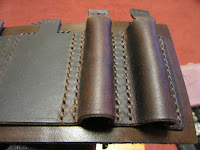Loops or pockets?
I had already decided that this ammunition slide would have pockets not loops before I had even started. As a rule of thumb the large big game calibres from 375 Holland and Holland up I prefer to stitch pockets, that is to say a longer loop with a stitched closed bottom end. The reason for this is that the pocket can be a looser fit as it does not have to hold the round as securely as a loop. The loop relies on tention to hold the round and stop it from coming out, while in the longer pocket the round is stopped from falling through by the stitched closed end. The advantage of this is that rounds can be more easily and quickly removed should a fast reload be required.
In the case of smaller calibres that would not be used for dangerous game, a fast reload would seldom be required as most rifles of this type have a magazine that holds more than enough to get the job done. That said if your preference is for pockets that would not be a problem.
Another thing I do with the larger calibres is to space each round out with two rows of stitching, this makes it easier to extract a round as its easier to get hold of an individual cartridge. I sew all of my products up by hand, using English saddle stitch. It produces a far stronger and more reliable product, it does take considerably longer that a sewing machine would take, but I do not mass produce, my products are bespoke and made to last.
After stitching all the loops, I stitch close the ends to form the pocket. The next step is to round off the corners and mark out the stitching line that will hold the front to the back, then very carefully punch the holes.



































